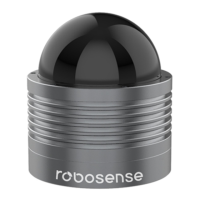8. Point Cloud
8.1 Coordinating Mapping
In data packet including the measured azimuth and distance, in order to calculating the
point cloud, the coordinate in polar coordinate system should be transferred to the 3D
XYZ coordinate in Cartesian Coordinate System, as shown in figure 10. The function of
how to transfer the information is as shown below:
Here
is the reported distance,
is the vertical angle of the laser (which is fixed and is
given by the Laser ID), and
is the horizontal angle/azimuth reported at the beginning of
every other firing sequence. is the angle offset of the azimuth. x, y, z values are the
projection of the polar coordinates on the XYZ Cartesian Coordinate System.
The angle.csv file including
and can be exported from RSView. Please refer to
Appendix B.13 and B.14.
Figure 10: Coordinate system mapping between polar system and XYZ system.
Note 1: In the RS-Bpearl ROS package, the coordinate system must be transferred to the
ROS right-hand Coordinate system.
The ROS-X axis is co-axis with the Y-axis and with same direction as Figure 10.
The ROS-Y axis is co-axis with the X-axis but the positive direction is reverse as Figure
10.
The Z axis is same before and after transformation.
Note 2: The origin of the LiDAR coordinate is defined at the center of the LiDAR structure,
with 94.27 mm high to the bottom of the LiDAR.

